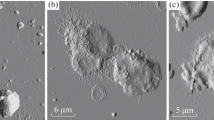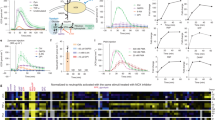Abstract
Granulocytes depend on anaerobic glycolysis for the energy required for chemotaxis, phagocytosis, and microbial killing. Two potential sources of the needed glucose are available: exogenous glucose and intracellular glycogen. These studies demonstrate that chemotaxin-induced movement of granulocytes induces accelerated uptake of exogenous glucose while phagocytosis does not, presumably utilizing instead the relatively slow process of glycogenolysis. As measured by incorporation of extracellular radiolabeled hexoses [1-14C]glucose or [3H]deoxyglucose), the soluble chemotaxin-aggregants of granulocytes, nF-met-leu-phe, CSades arg, bacterial filtrate, or arachidonic acid all augment transmembrane hexose uptake. This insulin-like activity closely parallels the dose-related effects of these agents on induction of granulocyte aggregation and chemotaxis. Insulin, itself, affects glucose transport minimally and mainly at supraphysiologic concentrations. In contrast, phagocytic stimuli fail to enhance hexose uptake at all, despite stimulating catabolism of glucose, which in turn is probably generated by glycogenolysis. These data show that granulocytes, whose motile function occurs in glucose-rich milieu, alter in tandem their cellular glucose uptake with their movement response. For phagocytosis, which often occurs in hypoglycotic, purulent exudates, granulocytes depend on stored energy supplies—probably glycogen. This coordination may be crucial in supporting granulocyte antimicrobial activity during acute inflammation.
Similar content being viewed by others
References
Stjernholm, R. L., C. P. Burns, andJ. H. Hohnadel. 1972. Carbohydrate metabolism by leukocytes.Enzyme 13:7.
Carruthers, B. M. 1967. Leukocyte motility.Can. J. Physiol. Pharmacol. 45:269.
Craddock, P. R., Y. Yawata, L. Van Samten, S. Gilberstadt, S. Silvis, andH. S. Jacob. 1974. Acquired phagocyte dysfunction: A complication of the hypophosphatemia of parenteral hyperalimentation.N. Engl. J. Med. 290:1403.
Stossel, T. P., F. Murad, R. J. Mason, andM. Vaughn. 1970. Regulation of glycogen metabolism in polymorphonuclear leukocytes.J. Biol. Chem. 245:6228.
Craddock, P. R., D. E. Hammerschmidt, J. G. White, A. P. Dalmasso, andH. S. Jacob. 1977. Complement (C5a)-induced granulocyte aggregation in vitro.J. Clin. Invest. 60:260.
Skubitz, K. M., andP. R. Craddock. 1981. The reversal of hemodialysis granulocytopenia and pulmonary leukostasis: A clinical manifestation of selective down-regulation of granulocyte responses to C5ades arg.J. Clin. Invest. 67:1383.
Craddock, P. R., White, J. G., Weisdorf, D. J., andD.E. Hammerschmidt. 1980. Digital integration of granulocyte aggregation responses.Inflammation 4:381.
Norton, J. M., andA. Munck. 1980. Glucose transport in murine macrophages: In vitro characterization of the monosaccharide transport system of the thioglycollate-elicited mouse peritoneal macrophage.J. Immunol. 125:252.
DeChatelet, L. R., T. L. Campbell, C. E. McCALL, P. S. Shirley, andC. L. Swenson. 1980. Oxidation of 2-Deoxyglucose by human polymorphonuclear leukocytes.Inflammation 4:249.
Fussganger, R. D., C. R. Kahn, J. Roth, andP. De Mets. 1976. Binding and degradation of insulin by human peripheral granulocytes.J. Biol. Chem. 251:2761.
Schwartz, R. M., A. R. Bianco, B. S. Handwerger, andC. R. Kahn. 1975. Demonstration that monocytes rather than lymphocytes are the insulin-binding cells in preparations of human peripheral blood mononuclear leukocytes: Implication for studies of insulin-resistant states in man.Proc. Natl. Acad. Sci. U.S.A. 72:474.
McAll, C. E., D. A. Bass, S. Cousart, andL. R. DeChatelet. 1979. Enhancement of hexose uptake in human polymorphonuclear leukocytes by activated complement component C5a.Proc. Natl. Acad. Sci. U.S.A. 76:5896.
Keuhl, F. A., andR. W. Egan. 1980. Prostaglandins, arachidonic acid and inflammation.Science 210:978.
Weisdorf, D. J., P. J. Flynn, D. E. Hammerschmidt, H. S. Jacob, andP. R. Craddock. 1980. Endogenous thromboxanes modulate the granulocyte aggregation, glucose uptake and locomotion stimulated by soluble chemotaxins.Clin. Res. 28:327A.
Zurier, R. B., andD. M. Sayadoff. 1975. Release of prostaglandins from human polymorphonuclear leukocytes.Inflammation 1:93.
Bass, D. A., J. T. O'Flaherty, P. Szejda, L. R. DeChatelet, andC. E. McCall. 1980. Role of arachidonic acid in stimulation of hexose transport by human polymorphonuclear leukocytes.Proc. Natl. Acad. Sci. U.S.A. 77:5125.
Sbarra, A. J., andM. L. Karnovsky. 1959. The biochemical basis of phagocytosis. I. Metabolic changes during ingestion of particles by polymorphonuclear leukocytes.J. Biol. Chem. 234:1355.
Stjernholm, R. L., andR. C. Manak. 1970. Regulation of pentose cycle activity and glycogen metabolism during phagocytosis.J. Reticuloendothel. Soc. 8:550.
Lehninoer, A. 1970. Biochemistry: The Molecular Basis of Cell Structure and Function. Worth Publishers, New York. 157.
Bass, D. A., M. J. Thomas, E. J. Goetzl, L. R. Dechatelet, andC. E. McCall. 1981. Lipoxygenase-derived products of arachidonic acid mediate stimulation of hexose uptake in human polymorphonuclear leukocytes.Biochem. Biophys. Res. Commun. 100:1.
Esmann, V. 1963. Effect of insulin on human leukocytes.Diabetes 12:545.
Englhardt, A., andT. H. Metz. 1971. Investigations on glucose uptake in isolated human leukocytes from normal and diabetic subjects.Diabetologia 7:143.
Leroux, J. P., J. C. Marchand, R. HoNG TuAN Ha, andP. Cartier. 1975. The influence of insulin on glucose permeability and metabolism of human granulocytes.Eur. J. Biochem. 58:367.
Tsan, M. 1979. Effect of phagocytosis by human polymorphonuclear leukocytes and rabbit alveolar macrophages on 2-deoxyglucose transport.J. Cell. Physiol. 99:23.
Weisdorf, D. J., H. S. Jacob, andP. R. Craddock. 1980. Granulocyte energy supply: Glycogenolysis versus exogenous glucose uptake.Clin. Res. 28:731 A.
Neal, H. M., L. R. Dechatelet, C. E. McCall, andD. A. Bass. 1981. Separable stimulation of glycogen phosphorylase or hexose uptake of human polymorphonuclear leukocytes.Fed. Proc. 40:791.
Scott, R. B. 1968. Glycogen in human peripheral leukocytes.J. Clin. Invest. 47:344.
Author information
Authors and Affiliations
Additional information
This work was supplied in part by grants from the National Institutes of Health: CA15627, HL19725, AM1573O, and HL07062. Dr. Craddock is a recipient of an N.I.H. Research Career Development Award, K04-00479. Dr. Weisdorf is a recipient of an N.I.H. New Investigator Award, AI 18160.
Rights and permissions
About this article
Cite this article
Weisdorf, D.J., Craddock, P.R. & Jacob, H.S. Granulocytes utilize different energy sources for movement and phagocytosis. Inflammation 6, 245–256 (1982). https://doi.org/10.1007/BF00916406
Issue Date:
DOI: https://doi.org/10.1007/BF00916406




